There might be affiliate links on this page, which means we get a small commission of anything you buy. As an Amazon Associate we earn from qualifying purchases. Please do your own research before making any online purchase.
Want to learn how to meditate, but don’t know the best way to get started?
Or are you wondering if meditation will actually make you happy?
Or do you often wonder how meditation can add value to your life?
If any of these questions sound familiar, then read on to check out this complete guide on how to start meditating. We will talk about the benefits of meditation and the different types of meditation available, and then we’ll detail a step-by-step plan to use to build this simple practice that will add a dose of happiness into your life.
First up, let’s talk about the benefits of meditation.
16 Proven Benefits of Meditation
Unless you know the concrete benefits that meditation can bring to your life, you probably aren't too interested in taking the time to do it.
But after reading about these 16 benefits of meditation, you will be rushing to find the space and time to start your practice.
1. It prevents overthinking or rumination.
Do you ever find yourself playing out past conversations in your head over and over to analyze what the other person really meant? What about thinking about all of the ways that a future encounter might turn out…especially the worst-case scenario?
Overthinking often leads to severe anxiety. But since meditation brings a sense of calmness, it helps with controlling your thoughts and emotions. Extensive research has shown how the calmness of meditation can decrease anxious thoughts and help people refocus their thinking.
2. Meditation reduces stress and anxiety.
Meditation promotes the “relaxation response,” which is a technique that combats the “fight-or-flight response.” The innate reaction of the fight-or-flight response differs from person to person depending on their past experiences.
For example, if someone has experienced a traumatic car accident, they may feel more stress the next time they are in a car than someone who has never been in a car accident before.
The fight-or-flight response is what we experience in times of stressful events. This physiological response to stress often includes a fast heart rate, quickened breathing, muscle tension, and perspiration.
Meditation reduces these symptoms by lowering your heart rate and blood pressure as you intentionally relax your muscles.
3. Meditation promotes better sleep quality.
Do you wake up in the morning feeling exhausted instead of refreshed?
An inexpensive way to beat insomnia is through meditation. Studies show that those who engage in mindfulness meditation can improve their sleep habits.

Meditation increases your brain's production of melatonin, which is produced by the same area of the brain that controls your sleep/wake cycles.
With this boost of melatonin levels, you will experience a more restful sleep. Meditation also increases serotonin levels, which also help regulate sleep, among other things.
4. Meditation stimulates productivity and creativity.
Cognitive psychologist Lorenza Colzato claims that meditation is an effective way to stimulate divergent thinking. Divergent thinking is a key driver that boosts creativity and productivity.
If you are someone who often has to be creative, you are likely familiar with the thrill that comes from the challenge of solving the problem at hand.
But it can be frustrating when you are cycling through the same ideas and the same thought patterns while trying to get to the solution, and really getting nowhere. During times that you have lost your creative flow, it can be difficult to make progress.
Meditation stimulates your neocortex, which is the area of the brain that does your creative thinking. In fact, studies have found that people who meditate think in a less rigid manner than those who don't, which allows them to be more creative.
5. It builds happier and stronger relationships.
A study on meditation and happiness explains that mindfulness meditation and self-compassion are predictors of happiness. Being in a state of happiness allows you to keep a positive perspective and have better and stronger relationships with other people.
Additionally, in order to have positive relationships with other people, you have to have a positive relationship with yourself.
This calming and focusing activity can help you get in touch with your true self—and the more respect you have for yourself, the better you will be at maintaining relationships. Your relationships with other people will benefit when you have more inner peace.
Meditation can also teach you about the power of forgiveness. Refusing to forgive someone can ruin a relationship, but by practicing meditation, you can learn to work through your issues and continue forward with the healing process.
Meditation helps people focus their attention on creating lasting connections and long-term relationships with other people.
6. Meditation decreases feelings of loneliness.
”Psychology Today” reports that meditation is a remedy for loneliness. It allows your brain to accept and understand things that make you sad, lonely, or depressed.
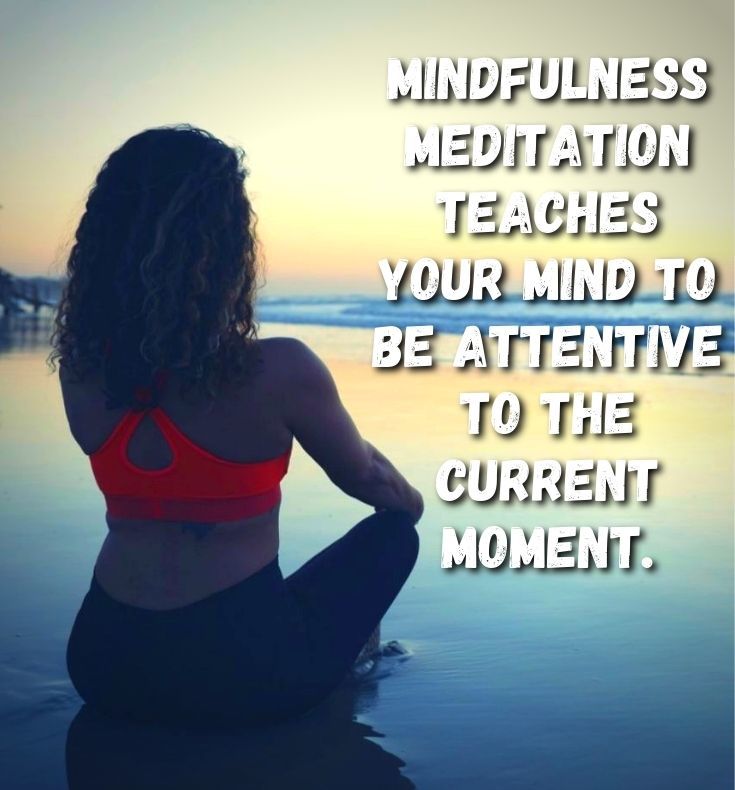
Studies have shown that practicing mindfulness meditation teaches your mind to be attentive to the current moment rather than dwelling on past events or projecting into the future. Simply being able to appreciate the present moment reduces feelings of loneliness.
7. It develops emotional strength and resilience.
According to research by Badri Bajaj and Neerja Pande, psychological resilience is more prominent in mindful people. They have the ability to cope with stressful situations and negative emotions better than others.
This may be because those who practice meditation are able to recognize negative thoughts as they come up, and then move past them. They do not dwell on their stress, or any negative emotions that arise. Rather, they can acknowledge the feelings and then refocus their thoughts.
8. Meditation cultivates a sense of compassion.
An article by ”Greater Good Magazine” explains that meditation helps us build self-compassion and compassion towards other people. Instead of worrying, meditation teaches people to control their feelings and emotions.
When you meditate, you develop a sense of self-awareness that allows you to get in touch with your emotions. This self-awareness helps you pick up on the subtle cues that your body and mood are sending, and adjust accordingly.
Further, people who meditate have been shown to lack compassion fatigue. Compassion fatigue occurs when people emotionally shut down and turn away from others who are suffering to protect themselves from experiencing vicarious trauma.
Those who meditate are able to protect themselves naturally from the distressful feelings that other people are having, and act with compassion to facilitate healing instead.
9. It improves focus and concentration.
Meditation primarily relaxes your brain to get rid of stress. When that happens, your brain becomes more functional, and you learn how to focus and concentrate. Another possible explanation for the increase in focus following meditation is the boost in gamma brainwave frequencies that occurs.
These brainwaves allow people to have an improved perception of reality due to increased sensory perception. This also increases overall focus and improves your ability to process information quickly and recall it later.
Meditation also helps improve focus and concentration because it allows your brain to go through the process of “whole brain synchronization.”
During this process, the left and right brain hemispheres work together, which allows for increased performance from the brain. This is critical for overall focus, as it lets you take in information and process it efficiently.
Practicing meditation is a habit common among successful people. To learn about the 12 best morning habits you can use to increase your focus, motivation, and energy for the rest of the day, take a few minutes to watch the video below:
10. Meditation provides mental clarity and alertness.
The practice of meditation develops the ability to be “present” by allowing your mind to stray from distractions and unnecessary thoughts. Since it allows you to stay calm and relaxed, your mind becomes clear and fully aware of what is happening around you.
Meditation helps you consciously provide your brain with oxygen while you're focusing on your breath. Have you ever noticed that you hold your breath while you are reading an email or you're in deep thought?
There’s even a term for this. “Email apnea” is when you forget to breathe when you're working. This term was created because 80% of people forget to breathe when using an electronic device. Meditation will teach you how to breathe deeply and give your cells the oxygen that they need.
11. It enhances overall cognitive performance.
Particularly during old age, meditation improves overall cognitive function while supporting overall mental health. A 2014 study explains that meditation can combat the occurrence of neurodegenerative diseases upon reaching old age.
The brain changes that occur during meditation and the reduction in stress that meditation leads to can slow the progression of cognitive disorders such as Alzheimer's disease and other forms of dementia.
What's more, meditation enhances neuroplasticity, which is your brain's ability to change its physical form and alter its functioning depending on your personal experiences.
Meditation is associated with increased cortical thickness, which is linked to an increased attention span and improved sensory processing. Additionally, long-term meditation is linked to an increase in the amount of gray matter in the brain, which is directly related to cognitive function.
12. Meditating inhibits the onset of mental disorders.
In relation to the last point, the practice of meditation at a young age can also inhibit the early onset of mental disorders when you grow older.
Stress can be a huge contributor to mental disorders, and meditation has been proven to reduce stress and the production of cortisol (the stress hormone).
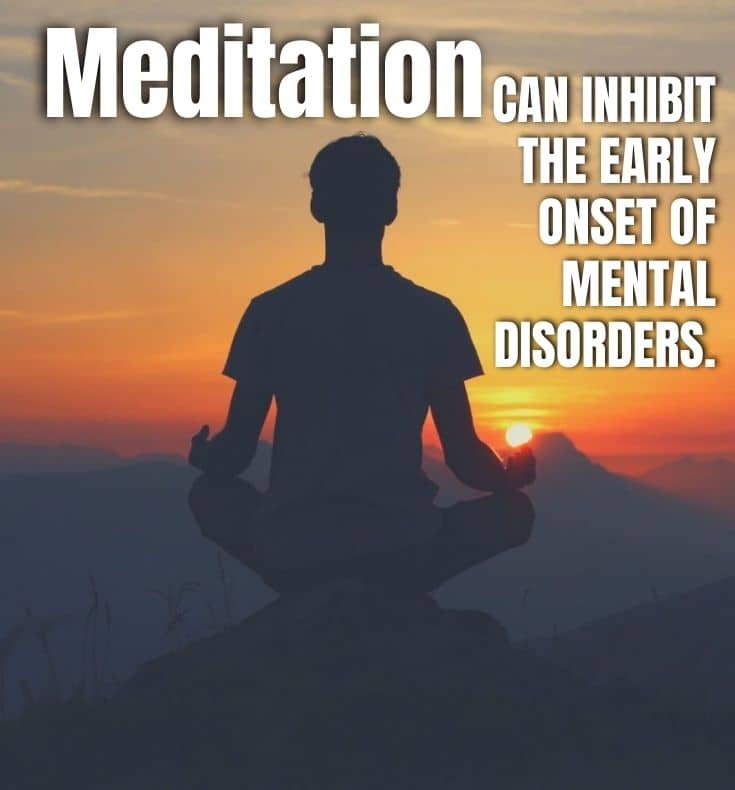
Also, because meditation helps improve sleep, you are able to give your brain sufficient time each night to restore itself and rest before the start of the next day. This also keeps your mind peaceful and reduces stress.
13. It works as a pain reliever.
Meditation, and particularly mindfulness meditation, is a cheap way to treat chronic pain and illness. ”Psychology Today” reports that meditation has been proven in clinical trials to diminish pain by 57%. If you keep on practicing it, you will be able to reduce the pain by over 90%.
Meditating has several benefits that can help reduce any pain you are experiencing. For example, it helps you become aware of the parts of your body that are not in pain and helps you notice how the pain you are experiencing changes in sensation. Noticing your pain in this way will diminish its intensity and alleviate your symptoms.
14. Meditating boosts your immunity and energy levels.
According to Mind Body Green, the electrical activity in the left side of your brain increases when you do meditation. This electrical activity regenerates more defense cells that can make your immune system stronger and more efficient.
Meditation (particularly a practice that includes yoga) releases endorphins. Endorphins relax your mind and body to help you become physically capable of doing activities with surges of energy.
At the same time, it decreases cortisol, which is important when it comes to having energy. Some studies have found that meditation can reduce this energy-depleting chemical by 50%, which could actually double your energy.
15. Meditation heightens sexual drive and libido.
When you’re stressed out, the cortisol and adrenaline levels in your body increase. These hormones can reduce your libido and poorly affect your sexual performance. Since the primary purpose of meditation is to relieve your stress, this means that it can improve your sex life, too.
Meditation can also increase the endorphins in your body, which are “feel-good” hormones. With this boost in mood, you will be more likely to want to be sexually active and physically close to another person.
16. Meditation regulates your blood pressure levels.
WebMD reports that high levels of stress can cause some irregularities in your blood pressure levels. Among other things, they suggest practicing meditation to combat the signs and symptoms of stress naturally. Likewise, a 2012 study has concluded that meditation can manage blood pressure levels.
The practice of meditation may positively impact activity in the autonomic nervous system, which regulates blood pressure. Specifically, meditation can reduce the narrowing of blood vessels when you are experiencing stress, and increase the widening of blood vessels.
Infographic Recap
Does meditation make you happy? Discover the 16 proven benefits of meditation in this infographic learn how it can make you happy.
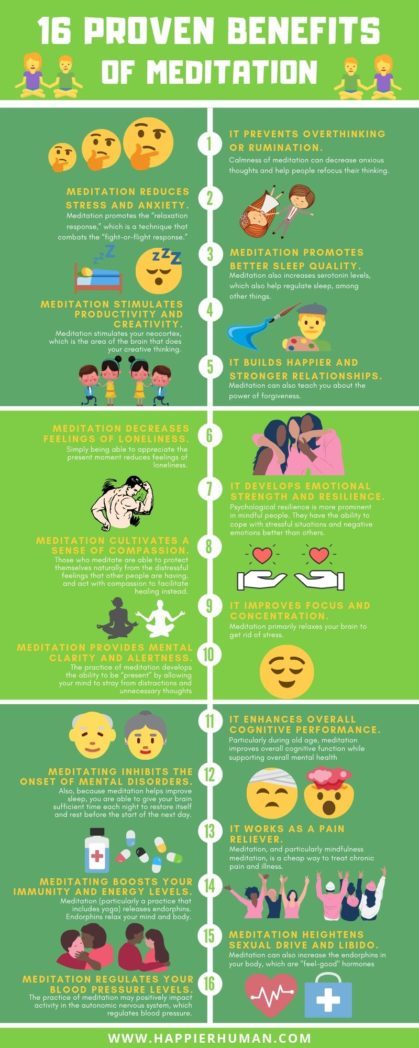
Now that you know why you should meditate, let's look at some options for how to meditate.
7 Common Types of Meditation
Some sources say that there are many kinds of meditation, but here are the most popular and widely used ones:
1. Mindfulness Meditation
This kind of meditation trains you to focus on what you are thinking or feeling at the moment. You can concentrate on your thoughts, feelings, or sensations.
This form of meditation is designed to help you develop the skill of paying attention to your experiences with acceptance and compassion. Mindfulness is a quality that you likely already have—you may just not have been taught how to use it yet.
Mindfulness meditation is non-judgmental and inviting of anything that enters into your awareness, either inside or outside of you. When you intentionally practice mindfulness meditation, you are deliberately paying close attention to yourself and your surroundings, allowing you to live more fully and be more present in your own life.
Also useful in mindfulness meditation is incorporating positive affirmations or mantras into your attempts at meditation. These mantras can help you focus and make meditation easier.
2. Loving-Kindness Meditation
One of the most prominent meditation styles, this type allows you to focus your energy to feel the warmth of love, kindness, and other positive feelings.
This meditation focuses on learning to soften the mind and heart and becoming open to deeper levels of pure love and kindness. Loving-kindness is not an emotional feeling of goodwill or an obligation to another person—it comes from a selfless place.
The feeling of loving-kindness is not dependent upon how another person feels about you. The process is about softening yourself and breaking down personal barriers and then breaking down the barriers that you feel toward other people.
People who practice this kind of meditation can forgive easily, connect with other people, and practice self-love.
3. Transcendental Meditation
This meditation technique promotes a state of relaxation by helping you avoid distracting thoughts and feelings. Those who practice this type of meditation say that it takes them to a state of pure consciousness.
The practice involves sitting down twice every day and repeating a mantra for 15–20 minutes with your eyes closed. Transcendental meditation is so popular that it has been incorporated into schools, businesses, and prison programs all around the world.
4. Zen Meditation
Zen meditation is the practice of preparing your body and mind to be calm in order to open yourself up to exploring the nature of your being. As you sit in specific positions and relax your mind, your heart rate and breathing will eventually slow down, and you will enter into a reflective, meditative state of mind.
Originally from China, this Buddhist meditation technique lets you delve within your spiritual state. It allows you to experience mental clarity and workability. Although it originated from China, the term “Zen” is a Japanese word meaning “meditation.”
5. Kundalini Yoga
The goal of Kundalini yoga is to increase a person’s vitality and consciousness. This practice is a mixture of physical and spiritual meditation, using a combination of dynamic movement, breathing, focus, and mantra chanting.
What has become known as modern “Kundalini yoga” is actually a combination of many traditions, including bandha, pranayama, and asana yoga, Patañjali's kriya yoga, tantric visualization of laya yoga, and other meditation techniques oriented towards awakening the spiritual energy at the base of the spine.
By practicing this form of meditation, people hope to be able to achieve their full potential and uncover their lives’ purpose.
6. Spiritual Meditation
This type of meditation allows your inner self to connect to something deeper than your being. It lets you reflect on your own dealings until you become fully aware of your spiritual being.
While secular meditation does not involve beliefs about non-material realities, spiritual meditation is any kind of meditation where the context of the practice evolves around non-material objects or abstractions, such as prayer or devotional meditations.
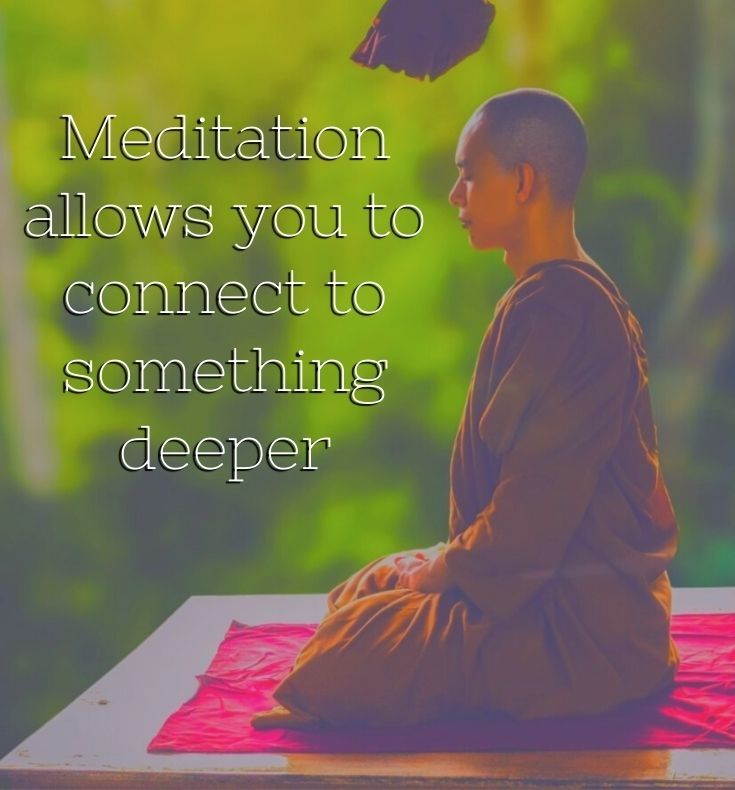
7. Vipassana Meditation
While most forms of meditation emphasize concentration or tranquility, this technique focuses on insight and having a clear awareness of what is going on around you, with a final goal of experiencing liberation.
Vipassana meditation originated in India, and it helps you transform yourself into a better person through self-observation. It focuses your thinking to the deep connection between your mind and body.
In vipassana mediation, you use your concentration as a tool to chip away at illusions that cut you off from reality. This is a slow process of gradually increasing your awareness of reality.
It takes years, but eventually, you are able to break through the illusions and find the light of reality. This is when the permanent transformation of liberation is complete.
These are the different types of meditations, but you are probably still wondering how to practice them. Let's look at a guide for beginning your meditative practices.
Infographic Recap
Want to know the common types of meditation? Discover the 7 common types of meditation in this infographic and learn how to practice them.

How to Meditate: A 14-Step Guide for Beginners
1. Schedule a time and a prompt for your meditation technique.
You are a busy person with a lot of things on your plate. But if you seriously want to start practicing meditation, you need to make time for it. Get rid of any excuses you may have used in the past to get out of learning to practice meditation.
If you are going to set the intention to do it, then you need to commit to it: the best time for meditation is before breakfast.
2. Use a prompt to motivate you.
Prompts help you get your body ready for meditation (e.g., drinking tea in the morning, or brushing your teeth). They send a signal to your brain that it’s time for you to meditate.
Because meditation requires your mind to be at peace, don't choose a trigger for your meditation that stimulates your mind, such as an exciting computer game or a dramatic book.
Avoid engaging in activities prior to your meditation that requires a lot of mental or physical energy. Some people find it helpful to do a relaxation exercise or some light stretching to get them in the proper state of mind for meditation.
3. Find a quiet and comfortable place to do your practice.
There are many places where you can meditate, but it doesn’t really matter where you want to do it as long as it is a quiet and comfortable spot. The reason for this is so that you won’t get interrupted while meditating.
Try to create a space in your home that stays uncluttered and serene for your meditation practice. It is ok if this space is small, as long as it is not chaotic. It is best if you have a sacred space that you can personalize to your liking.
4. Make yourself comfortable.
The most common position for meditation is sitting. This doesn’t mean, however, that it is the only choice you have. You can sit, use a meditation cushion, kneel, or stand—whichever makes you feel the most comfortable. Additionally, you might want to wear loose clothes to allow yourself to breathe properly.
The point here is to prevent any physical distractions, such as an uncomfortable chair or a cold room. You want to be able to focus on your awareness, not the pain in your hips because you're sitting on a hard floor.
5. Notice what your legs are doing.
Whether you are sitting, kneeling, or standing, make sure that your legs feel comfortable. Choose a good cushion or chair so you can keep your legs relaxed when meditating.
You don't want to have to be actively using the muscles in your legs to be able to stay in your position. You want to find a position that allows your body to feel supported and stable.
6. Sit up straight, but make sure that you’re relaxed.
There are three considerations you should make when choosing the best meditation position: alignment, relaxation, and stillness. Be like a puppet attached to a string. Sit straight, but allow your spine to feel comfortable.
Inhale as you roll your shoulders up to your ears, then exhale as you roll your shoulders back down. This will help properly place your head atop your neck while keeping your shoulders over your hips.

Maintain this tall, neutral spine for the duration of your meditation practice. If you ever feel yourself slumping forward, reset your spine with this breathing and shoulder-rolling movement.
7. Feel and think about your arms.
You are allowed to keep your arms comfortable by loosening up. Let your elbows bend slightly, and put your upper arms in a position parallel to your upper body.
After that, rest your palms on top of your legs, either in your lap or on top of your knees. Again, find what works best for you and stick with it.
8. Soften your gaze.
Some meditation techniques let you meditate with your eyes open, while others require you to keep them closed. But according to expert meditators, a good practice would be to soften your gaze by looking slightly downward. Forcing your gaze causes your eyes, neck, and face to become tense, but once you soften your gaze, all of these muscles relax.
You can soften your gaze by closing your eyes, taking a deep breath, and slowly reopening your eyes. You might have to blink a few times to get your gaze just right, but you will eventually find what is most comfortable for you.
9. Keep your entire body relaxed.
This has to be done slowly but surely. Don’t relax your body parts all at once. You can start with your toes, then your feet, and then let the rest of your body follow.
According to Wildmind, keeping your body relaxed is an “integral part of the process,” as you won’t be able to successfully meditate with an uncomfortable posture. Do periodic, full-body scans throughout your meditation session to make sure that you are staying relaxed.
10. Think about what your purpose and intentions are.
Mindful suggests that, when meditating, the practice should be done with intentions and not goals. You should meditate because you want to meditate, and not because you want to achieve something through it.
Unlike with a goal, with an intention there is not a required result—you are just connecting with what you are doing. An intention can't fail. The goal is simply a part of the intention.
11. Focus on your breathing.
According to meditation experts, you should allow yourself to breathe naturally when meditating. Start with several deep breaths. Inhale through your nose, then exhale through your mouth. But what’s most important is that you focus on the flowing in and out of the air in your respiratory system.
Don't rush or pause—just find a smooth and even pace. All you need to do is observe the sensation of air entering and exiting your lungs. Any time that you realize your awareness has wandered off during meditation, gently redirect it to your breath.
12. Pay attention to your wandering mind, and don’t fight with it.
Beginners usually find their minds wandering when they start doing meditation.
Mindful affirms that this is perfectly fine, and you don’t have to force yourself to forget your thoughts. If you catch your mind wandering while meditating, gently return to the present by focusing again on your breath.
Some people find it helpful to count their breaths if their minds frequently wander off, or if they tend to get carried away by a passing thought. It takes practice to stay focused during meditation, so don't be discouraged if this is challenging at first.
13. After your meditation, slowly lift your gaze.
As you lift your gaze, your brain will begin to recognize the sounds, smells, and atmosphere around you. As this happens, pay attention to what you are feeling internally—both physically and mentally.
It’s totally up to you how long you would like your meditation process to take. For beginners, though, it is recommended that you start with shorter sessions (e.g., 10 minutes).
Once you become comfortable and used to meditation, you may begin practicing for longer periods.
14. Bring your attention back to the present.
When you’re done meditating, don’t just jump to your feet and rush on to the next item on your to-do list. You need to first acknowledge your surroundings. Slowly wiggle your toes and fingers, then start moving your hands, feet, and the rest of your body.
Take the time to progressively go through your entire body from head to toe, and “wake it up” with a little bit of movement. Take a moment to notice your surroundings and what’s going on around you. Practice gratitude as you take your time to appreciate everything.
Infographic Recap
Want to learn how to meditate, but don’t know the best way to get started? Follow the steps found in this infographic and start your practice of meditation.
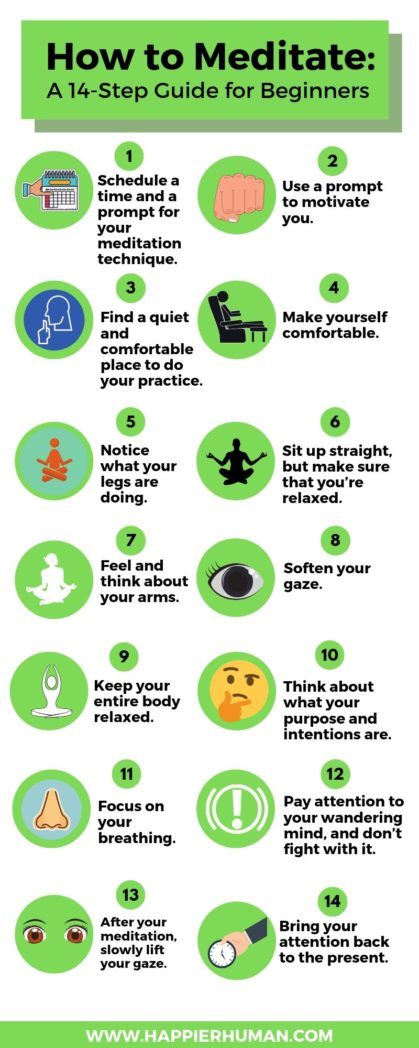
Final Thoughts on How to Meditate
Learning the art of meditation requires hard work, perseverance, and a great deal of self-discipline. It won’t be easy at first, but once you learn how to do it and actually get used to it, all your efforts will surely be worth it.
As mentioned above, meditation can provide you with a lot of benefits: physical health, mental health, and even emotional stability. It can generate positive emotions that can lead to a healthier and happier life.
In this article, we learned what meditation is, what the types of meditation are, and how to actually start your practice of meditation. But most importantly, we explored how meditation can significantly increase your feelings of happiness.
We hope that, with these tips, you can successfully start your practice, eliminate much of your stress, and ultimately become a happier human.
And if you're looking for more resources to improve your meditation practice, be sure to read these posts:
- 11 Mental & Health Benefits of Practicing Mindfulness
- 27 Mindfulness Activities for Seniors & the Elderly
- 15 Mindfulness Activities for Adults
Finally, one proven way to improve your happiness and life satisfaction is to focus on goals that truly matter. To get started, check out this FREE printable worksheet and a step-by-step process that will help you set effective SMART goals.


